Type-XXI-U-Boat-of-World-War-Two
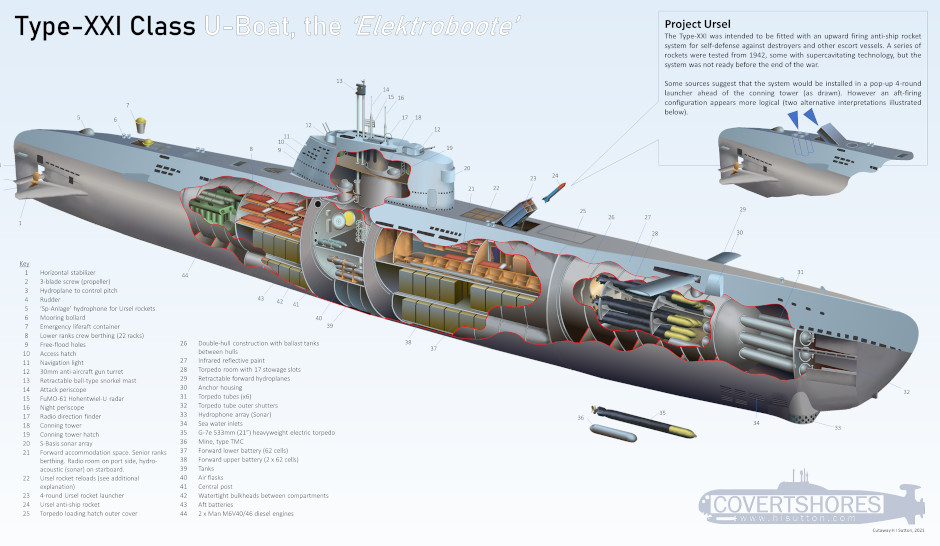
Original artwork of Type-XXI submarine. CLICK to enlarge.
New Cutaway of Gernan Type-XXI Submarine
 The Kriegsmarine’s Type-XX1 U-boat, known as the Elektroboote’, is rightly considered the most advanced submarine of World War Two. It was slicker and stealthier and than any other boat and incorporated both technical and doctrinal advances. And it is widely considered the first ‘true submarine’ because it was designed to spend all of its time underwater.
The Kriegsmarine’s Type-XX1 U-boat, known as the Elektroboote’, is rightly considered the most advanced submarine of World War Two. It was slicker and stealthier and than any other boat and incorporated both technical and doctrinal advances. And it is widely considered the first ‘true submarine’ because it was designed to spend all of its time underwater.
German U-boats (Unterseeboot - submarine) had been particularly effective during the early stages of the war. But the allies had developed increasingly effective defenses (not least the breaking of the German Enigma codes). So by the late war the Kreigsmarine’s submarine fleets were being decimated. With the advanced Type-XXI the Germans hoped to regain their former power on the high seas.
One less well known aspect is that it was to be fitted with an upward firing anti-ship rocket system.
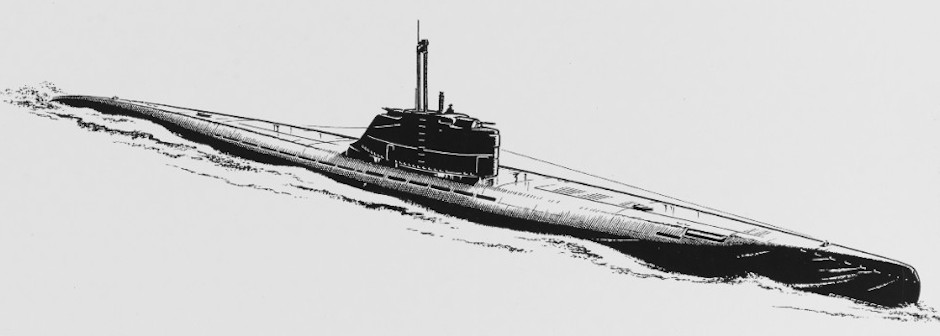
US Navy sketch of the Type-XXI, probably made for intelligence purposes during World War II. US Navy Photo (Naval History and Heritage Command).
Up to this point submarines had operated mostly on the surface, especially during long transits. The Type-XXI used its snorkel (a Dutch invention) to remain substantially submerged even when running on its diesel engines – the snorkel provided air for the engines. German submarines had been using snorkels for a while but the Type-XXI’s was integrated into the sail to reduce drag.
Snorkeling greatly reduced the submarine’s susceptibility to being detected by radar. But the small snort mast was not entirely invisible to radar. So the Germans added a dipole receiver to the top of the snorkel to warn of enemy radar transmissions. This potentially allowed the submarine to drop the mast before it was detected by the passing aircraft or ship.
The snorkel wasn’t the only way that the submarine could operate submerged for longer. The ‘Elektroboote’ had considerably more batteries than previous submarines. This allowed it to operate underwater for much longer.
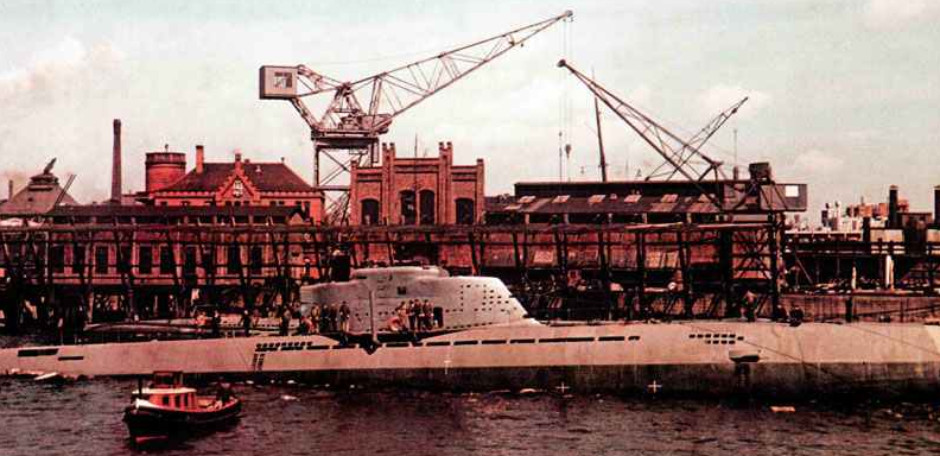
Type-XXI. Image from WW2 Weapons
Another improvement was that the old fashioned deck guns for attacking merchant vessels were removed. Instead the all-torpedo main armament was concentrated in the bow (no aft tubes). This reflected operational lessons and the realities of the Allies’ dominant anti-submarine capabilities.
Get The essential guide to World Submarines
This Covert Shores Recognition Guide Covers over 80 classes of submarines including all types currently in service with World Navies.
Check it out on Amazon
Project Ursel
The Type-XXI was intended to be fitted with an upward firing anti-ship rocket system. This short range system would have provided self-defense against destroyers and other escort vessels. A series of rockets were tested from 1943, some with supercavitating technology, but the system was not ready before the end of the war. Ranges varied but reached 220 meters (720 feet) and speeds of up to 60 meters per second (116 knots).
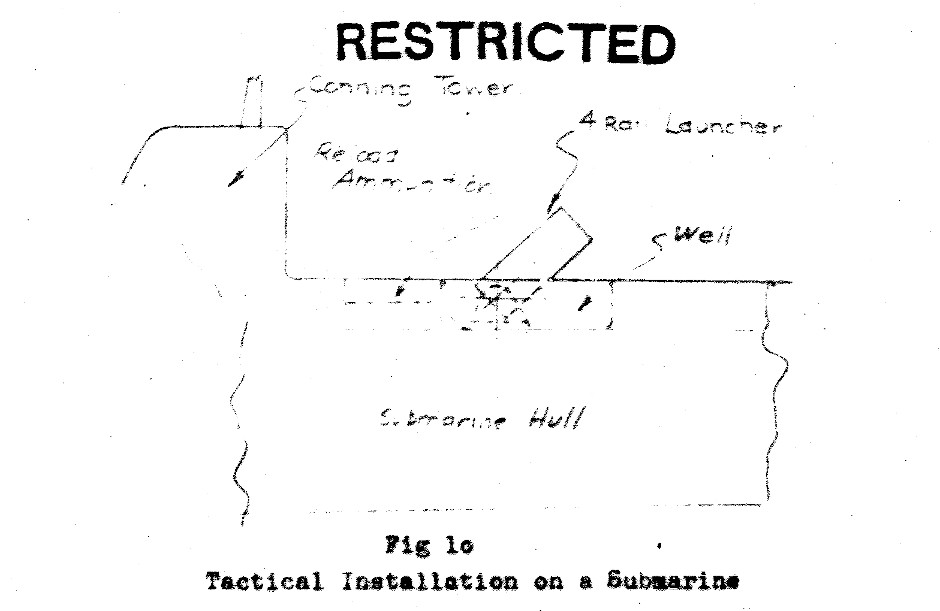
Some sources suggest that the system would be installed in a pop-up 4-round launcher ahead of the conning tower. This would be trained onto the target and automatically fired by the Sp-Anlarge sonar system. However an aft-firing configuration appears more logical as destroyers would typically be approaching from the stern. One hint is that the lathe, which is in the aft compartment, may have been installed in its place on the vessels built.
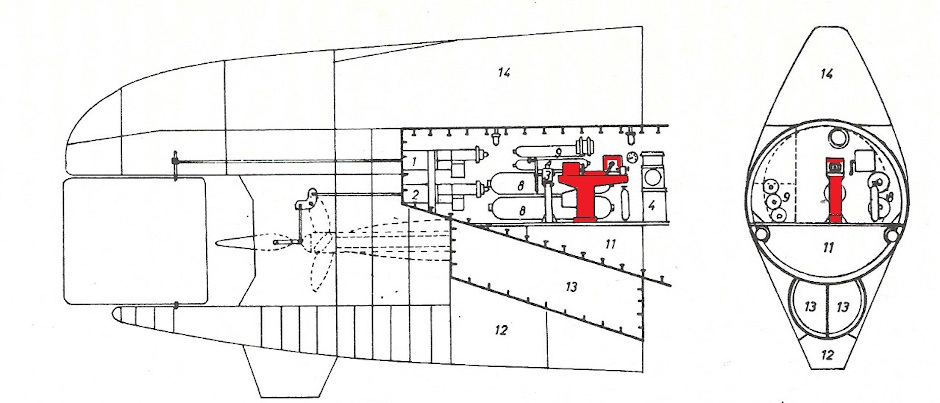
The lathe (red) was apparently fitted in place of the Ursel system
Conceptually this highly automated underwater self-defense system was ahead of its time. And nothing like it was fielded after the war despite the allies being aware of it.
Learn EVERYTHING about Special Forces subsCovert Shores 2nd Edition. A world history of naval Special Forces, their missions and their specialist vehicles. SEALs, SBS, COMSUBIN, Sh-13, Spetsnaz, Kampfschwimmers, Commando Hubert, 4RR and many more.
Check it out on Amazon
Torpedo Room
Earlier submarines tended to use the torpedo room for crew berthing. This reduced the number of torpedo reloads and made it slower to load the tubes. The Type-XXI’s torpedo room was dedicated to weapons with a maximum number of rounds stowed. There were 17 positions (8 on either side and one in the gutter). This gave a maximum practical load out of 20 torpedoes (3 of the slots being empty to allow rotation of the weapons into the tubes). This compares to 14 torpedoes for the earlier Type VII u-boat, including a stern torpedo room. US Navy Tench class submarines carried up to 27-28 torpedoes but these were much larger and had a stern torpedo room.
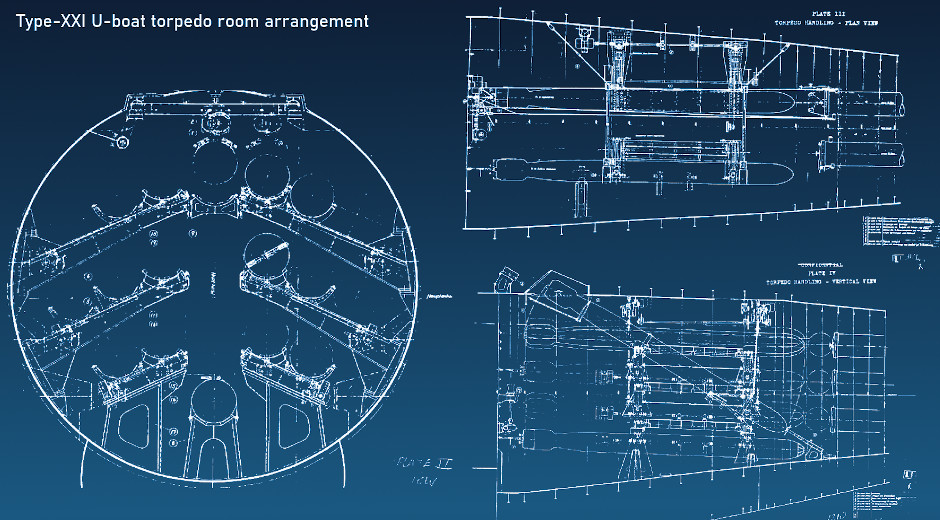
The arrangement had the torpedoes on lightweight chocks, sloping slightly downward to align to the tubes. These were also sloped downward. Reloading was mechanically assisted and could be cycled quite quickly.
Specifications
Displacement: 1,621 tons surfaced, 1,819 tons submerged
Length: 76.7 m (252 ft)
Beam: 8 m (26 ft)
Draft: 6.32 m (21 ft)
Speed: 15.6 knots surfaced, 17-18 knots submerged
Maximum depth: 135 meters (443 ft)
Range, surfaced: 15500 mi. @ 10 knots on 2 engines. 11150 mi. @ 12 knots (maximum sustained speed) on 2 engines.
Range, submerged: 365 mi. @ 5 knots on 2 engines, snorkelling. 285 mi. @ 5 knots on batteries. 170 mi. @ 8 knots on batteries. 110 mi. @ 10 knots on batteries.
Propulsion: 1 x 580 hp diesel engine, 1 x 580 hp deisel generator, 1 x 1400 hp electric motor and 1 x 70 hp silent ‘creep’ engine
Crew: 57
Armament: 6 x 533mm (21”) torpedo tubes with a total of 20 torpedoes. 2 x twin 30 mm in turrets with 3800 rounds.
The World’s ONLY Guide to
Narco Submarines
10 years of research, analyzing over 160 incidents, condensed into a handy guide. This unique book systematically breaks down the types and families. With detailed taxonomy, recognition 3-views, profiles and photos. Available on Amazon
Engineering
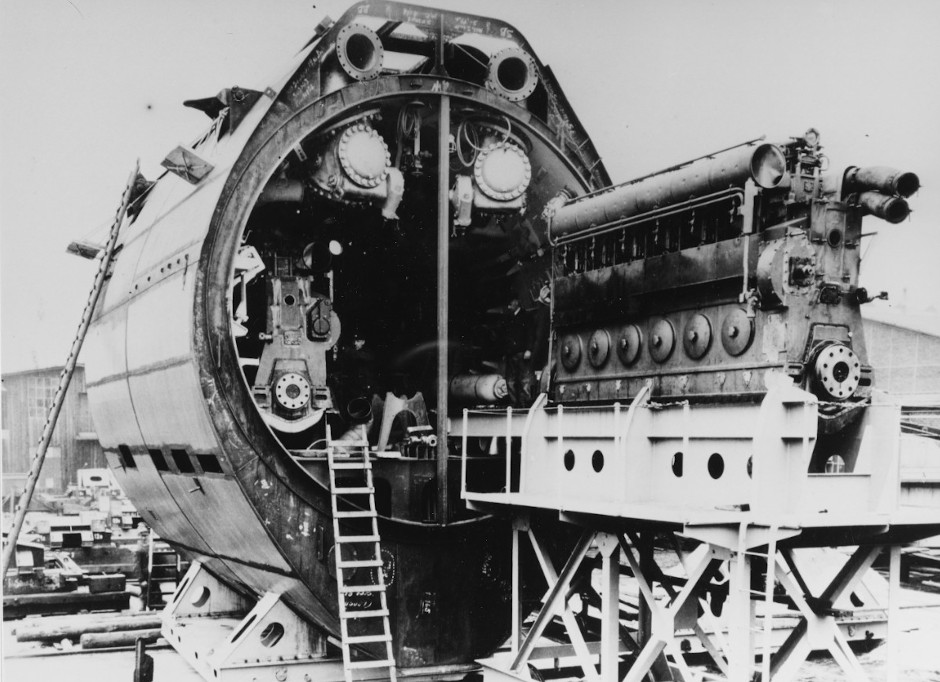
An uncompleted stern module of a Type-XXI with a Man diesel engine lined up. US Navy Photo (Naval History and Heritage Command).
The Type-XXI had twin Man M6V40/46 6-cyclinder 4-stroke diesel engines. These were originally intended to be supercharged but it appears that these were not fitted in the end. The diesels drove twin screws which could also be run from electric motors as was typical at the time. However two 113 H.P GV323/28 electric motors were fitted. These were termed creep motors and allowed very quite running at slow speeds.
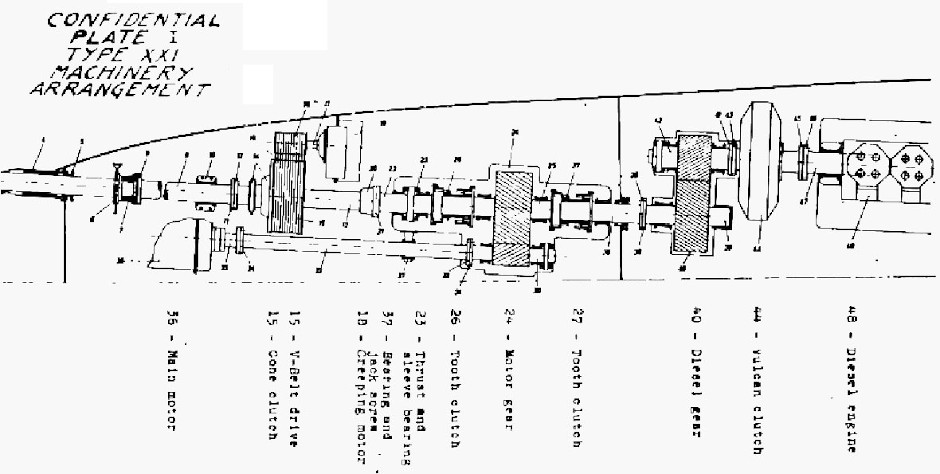
Fate
Relatively few Type-XXIs were completed before the end of the war and the type came too late to make a difference in the outcome. Only One Type-XXI, U-2511 (Schnee), made a war cruise at all: it was outbound on the day of surrender.
The hulls and parts which were completed, inevitably perhaps, were not built to a high quality. And it is clear that the design had some teething problems. But a few hulls were acquired by each of the victorious powers. These were extensively tested. A few served operationally, for example the French Navy’s Roland Morillot. The USSR also operated some for a period of time.
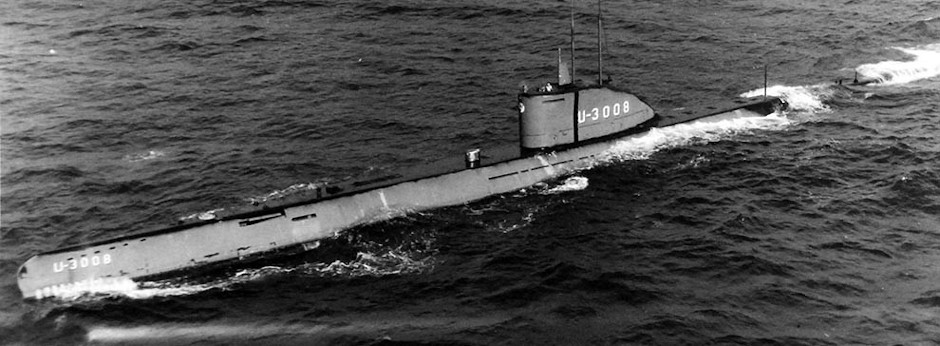
Captured U-3008 was studied and tested by the US Navy
Despite some organizational inertia (‘not designed here! Not how we think a submarine should work), many lessons were drawn from the boat. New submarines built after World War Two were heavily influenced from the type-XXI. The most often cited of these was the Soviet Project 613 WHISKEY class, but numerous types were similarly impacted.
Related articles (Full index of popular Covert Shores articles)

 Type-XXIXH stealth U-Boat. w/Cutaway
Type-XXIXH stealth U-Boat. w/Cutaway

 World war One Type UC-1 U-boat w/Cutaway
World war One Type UC-1 U-boat w/Cutaway


 Type-212 AIP submarine w/Cutaway
Type-212 AIP submarine w/Cutaway

 Surcouf Cruiser Submarine w/Cutaway
Surcouf Cruiser Submarine w/Cutaway

 Project 617 ‘WHALE’ AIP Submarine
Project 617 ‘WHALE’ AIP Submarine

 Japanese Ko-Hyoteki midget submarine of WW2 - Pearl Harbor attack
Japanese Ko-Hyoteki midget submarine of WW2 - Pearl Harbor attack

 Japanese Ha201 Sen-Taka-Sho fast attack submarine of WW2
Japanese Ha201 Sen-Taka-Sho fast attack submarine of WW2

 WW2 German Delfin midget submarine with AIP
WW2 German Delfin midget submarine with AIP







